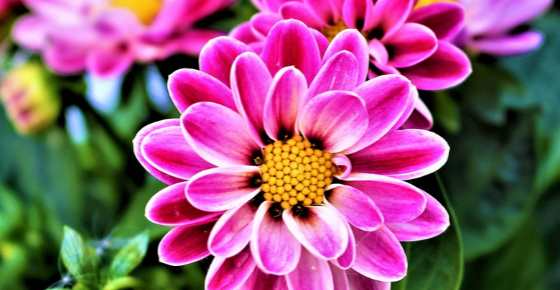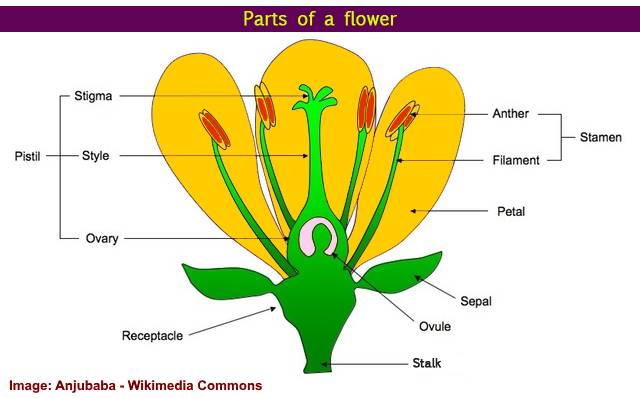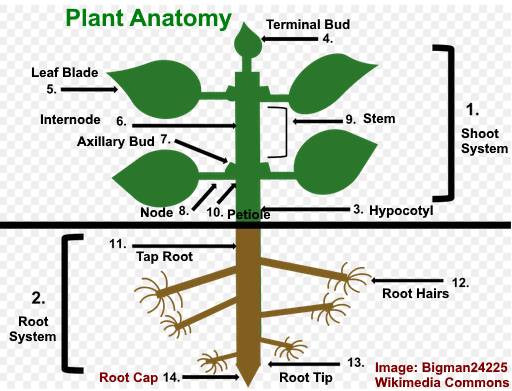Parts of Flower and Plant (Pistil, Sepal, Stamen and More) With Diagrams of Flower and Plant

There are many different types of flowers but most of them have the same basic parts. Plant flowers contain female parts called pistil and male parts called stamen which allow the plant to reproduce. The flower is attached to the stalk which is a central shoot that also holds the leaves. The function of the stem is to support the plant and transport nutrients to the leaves and flowers.
Of course, flowers and plants have many other parts, each with its own specific function. In this guide to the parts of flower and plant, you will learn what makes them so amazing. After all, we all use different plant parts in our diet and for their healing benefits.
This article includes anatomy illustrations of the flower, stem, pistil, sepal, stamen and more. This is an extensive guide that includes 7 plant and flower diagrams illustrating their different parts.
Complete Flower Vs. Incomplete Flower
Botanically, a flower is considered to be complete flower if it contains the four main parts of a flower: petals, sepals, stamen, and carpel (also known as a pistil). If a flower lacks any one of these parts, it is an incomplete flower.
Rose, hibiscus and tulip are complete flowers because they have all the main flower organs. The flowers of holly, corn, squash and grasses are incomplete flowers.
Perfect Flower Vs. Imperfect Flower
A flower is considered to a perfect flower when it contains the male (stamen) and female (carpel / pistil) reproductive parts. A perfect flower is also called bisexual bloom because it contains both female and male parts. Flowers that contain either stamen or pistil are called imperfect or unisexual flowers.
Parts of a Flower (Flower Anatomy) Including a Flower Diagram
Flowers are the parts of plants that give them beauty, scent, and they function as the plant’s reproductive system. Flowers attach to the plant via the stalk.
The Structure and Functions of Flowers
A flower has female and male parts. The male part of a flower is the stamen. The female part of a flower is called pistil, and it is composed of parts named stigma, style, and ovary. Petals of various colors surround the male and female reproductive parts.
In a similar way to how the human reproductive systems work, the ovary needs to be fertilized to produce a new baby plant. This happens when pollen lands on the stigma and it releases sperm cells. These travel down the style to the ovary where they fuse with an egg and start to grow.
Pistil (The Female Part of the Flower)
The pistil functions as the female reproductive part of the flower that comprises of the stigma, style, and ovary.
Sometimes the term carpel is used in place of pistil. In some cases, a carpel and pistil are one and the same thing. However, in some flowers, the 2 or 3 carpels fuse together to form a pistil.
Stigma
The stigma in flower is the upper part of the pistil that receives the pollen. The stigma sits on top of the style and traps pollen due to its hairy or sticky surface.
Parts and Function of the Ovary in the Flower
When looking at a diagram of a flower, the ovary is the enlarged part located at the base of the pistil. The function of the ovary is to protect its ovules that fertilize pollen that reaches down the pollen tube.
One of the reasons why flowers are necessary for fruit-bearing plants is for fruit to form properly. Once fertilized, the ovary develops into fruit that contains seeds.
Stamen (The Male Part of the Flower)
The stamen is the part of the flower that carries pollen. The stamen is made up of two parts:
- Filament is the hair-like stalk
- Anther is at the end of the stalk and holds the pollen
Sepal
The sepals are the green leaves surrounding the bud before it flowers. The function of sepals is to protect the flower in the bud stage and also support blooming flowers. The sepal generally falls off after flowering.
Petals
The bright color of petals functions as a way to attract bees, insects, and birds that pollinate the plant.
Although petals aren’t directly involved in the plant’s reproductive system, the play an important function.
The petals of some flowers produce scents that either attract or repel certain pollinators. The color of petals is also important to attract pollinators that have a poor sense of smell. Also, larger petals attract pollinators from longer distances.
Petals are actually leaves of the plant the same as sepals are.
Parts of a Flower Diagram
Looking at a diagram of a flower, you can easily see the individual parts of the flower. The pistil and stamen in the middle of the flower are surrounded by brightly colored petals.
Plant Parts and Their Function (Including Diagrams)
Beautiful flowers are just one part of plants that add to their important function. Each part of the plant carries out a specific function to enable the plant grow properly.
The main factors involved in healthy plant growth are sunlight, that gives energy to plants through the leaves, and water and minerals that get absorbed through the root system.
However, many parts of plants have multiple functions. For example, the roots both help keep the plant anchored in the ground and also take in minerals and moisture from the soil. The stems function to both transport water and minerals from the roots to leaves and support the plant.
It is also good to remember that plants also function as the main source of life for humans. Plants are a rich source of nutrients, vitamins, and minerals in our diets. Even meat lovers depend on animals that feed on plant matter for their food.
Many plants also have a healing function and are used in many natural remedies. Extracts from plants in the form of essential oils, tinctures, and juice contain phytochemicals with medicinal properties.
Let’s look in more detail at all the many parts of a plant and their functions.
Plant Roots
The plant root system is one of the most important parts of the plant and is generally located below ground.
Roots function as the principle way plants get nourishment in the form of water, minerals, and other nutrients.
There are many types of plant root, for example:
Taproot system. Plants with taproots have a large, thick central root from which other hair-like roots develop. Plants that have taproots also function as functional foods. For example, carrots, parsnips, potatoes, beets, and radishes are all example of plants that are good for you.
Fibrous root system. Fibrous root plants have thin small roots that grow downwards and also branch out.
Creeping roots. These shallow and long roots don’t go deep into the soil and can cover a large area.
Tuberous roots. Thick roots that store up food for the plant.
Adventitious roots. Roots that start above the soil from the stem and then go down into the soil.
Function of the Stem
The stem is necessary for the plant to transport nutrients and water throughout the plant and to connect the leaves and flowers. The stems also help to transport food produced by the leaves to the flowers and roots.
Stems are also connected to the function of the leaves to make sure the plant gets enough food. For example, stems need to grow tall enough so that the leaves can get sunlight.
Some types of plant stems are also edible. Some examples of edible stems include asparagus, broccoli, cauliflower, and rhubarb.
Leaves
The function of leaves is to make food that gives the plant energy and encourages healthy growth.
Leaves come in many shapes, textures, and sizes and are found at the end of stems on plants. Together the leaf and stem form a shoot which is usually the first stage of plant growth.
Plant leaves also breathe by allowing plants to “inhale” and “exhale” air. Leaves also give off moisture and can also absorb moisture through their leaves.
Some plant leaves are simple leaves that only have a single blade and a single main vein. Other leaves called compound leaves and are made up of small leaves that attach to a central stem. Some succulent plants such as aloe vera have thick fleshy leaves that contain a lot of moisture.
Leaves are also important parts of the plant that we eat. The leaves of many plants are a rich source of vitamins and minerals.
Flowers
The function of plant flowers could be broken down into two main parts. There is the reproductive part that is necessary for new plants to grow, and the vegetative part with its leaves and petals.
The main function of flowers is to produce seed. We have already looked at the female part of the flower and male part of the flower that is involved in reproduction.
The 4 parts of the flower involved in reproduction are the following:
- Sepals are the green leaves that protect the bud before it flowers.
- Stamen is the male flower part that has the pollen on it.
- Pistil is the female flower part that contains the stigma, style, pollen tube, and ovaries.
- Petals aren’t involved in the reproduction process but their function is to attract pollinators.
Bright petals, flowers, and colorful blossoms are one of the most attractive parts of any plant.
Flowers and plant blossoms are often consumed in the form of herbal teas and spices. Examples of edible plant flowers include zucchini flowers, nasturtiums and calendula. Essential oils are often produced by extracting the therapeutic properties from flowers.
Fruits
Fruits are one of the most delicious parts of plants we enjoy eating. Fruits develop in the flower when pollination occurs and egg cells in the ovules are fertilized. The ovules develop into seeds and the ovary begins to ripen.
Some fruits develop into fleshy fruits such as nectarines, lemons, apples, and strawberries. Other “fruits” are hard such as nuts.
Fruits are classed as fleshy edible products of flowering plants that contain a seed. This means that some plant products we tend to think of as vegetables are actually fruits.
For example, tomatoes, eggplants, and bell peppers are actually a type of berry fruit. Cucumbers are also technically classed as fruits because they have a fleshy structure that contains seeds.
Seeds
Without seeds, new plants can’t grow. Seeds contain all the necessary parts that develop into another plant. Each seed is an embryo that will start to germinate and grow under the right conditions.
The first sign of a seed sprouting is a tiny leaf that is connected to a thin stem. As the sprout grows, it develops roots, the stem becomes thicker, leaves appear, and eventually flowers.
Dioecious Plants Vs. Monoecious Plants
“Dioecious” and “monoecious” are horticultural terms that relate to plant reproduction. Dioecious describes a plant group that includes distinct male and female plants. This means that the male and female flowers are on different plants. Monoecious describes a single plant that have both male and female flowers.
Dioecious and monoecious plants both have unisexual or imperfect flowers.
How Leaf Anatomy Helps Plants to Function
The function of any plant relies on the plant’s leaves. The plant leaf is a small factory that produces energy through a process called photosynthesis. Leaves also produce oxygen and absorb carbon dioxide from the atmosphere.
Chlorophyll is the main chemical in leaves that makes them function properly. This is a green pigment that is responsible for the color of leaves.
The main parts of a leaf are the epidermis, cuticle, veins, and stoma. The cuticle is the waxy surface that covers the epidermis of the leaf. This allows the plant to “breathe” through the stomata (plural of stoma – a tiny opening or pore) as it draws in carbon dioxide and gives off oxygen. The veins running through the leaf transport nutrients and water throughout the plant.
Photosynthesis and Plant Function
One of the most important functions of plant leaves is to convert the sun’s rays into energy. This is a process called photosynthesis and is the reason why leaves are green.
For photosynthesis to happen, a number of factors are needed. Photosynthesis requires energy from the sun, carbon dioxide, water, and chlorophyll.
The leaves get water through the plant’s root system and absorb sunlight and carbon dioxide during the daytime. Chlorophyll breaks up water into hydrogen and oxygen. During this process, carbon dioxide and hydrogen combine to produce sugars. This provides energy for the plant and also releases oxygen into the atmosphere.
Parts of Plants and Flowers that are Useful to Us
It is clear to see that plants have an important function in helping to sustain life on earth.
Here are a number of ways that parts of flowers and plants are important for our health:
Food. Many plant leaves, roots, flowers, and stems are edible and are an important source of vitamins, minerals, fiber, and other nutrients.
Medicines. Extracts of many plants have medicinal properties that can help address a number of ailments. Parts of plants can be used to make therapeutic herbal teas, essential oils, or taken as supplements.
Pleasing to the eye. Flowers, blossoms, and colorful petals are pleasing to the eye. Having houseplants or freshly cut flowers can brighten up a room, create pleasant aromas, and may help clean the air.
Related articles:






